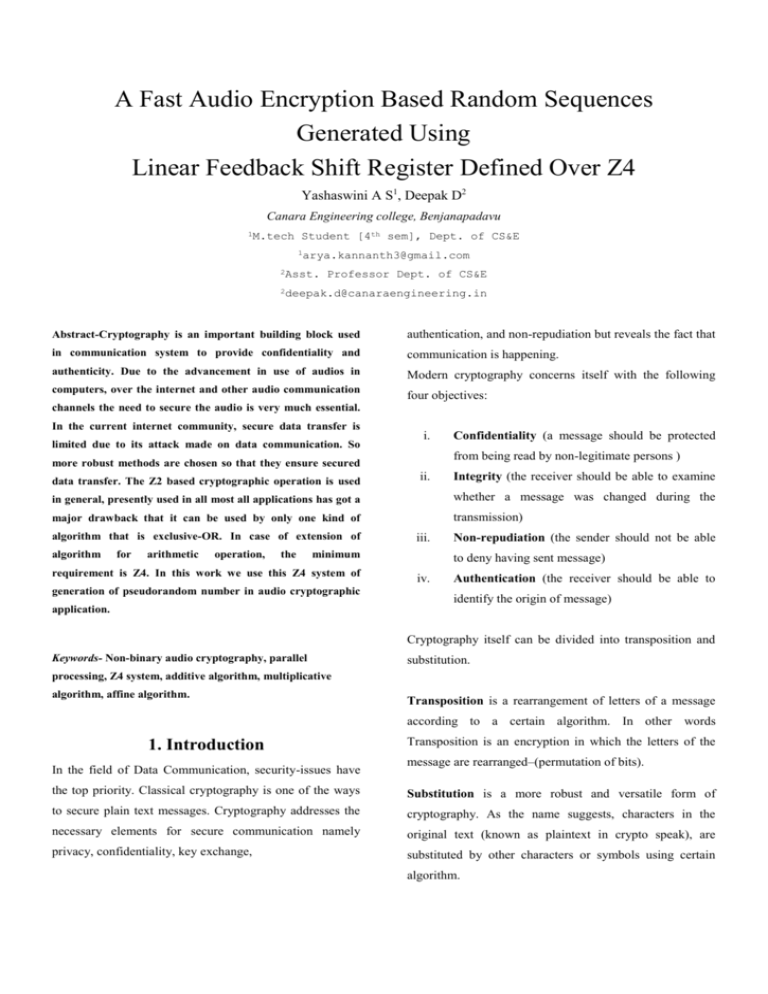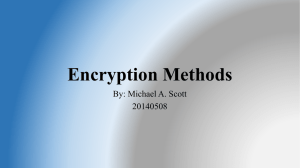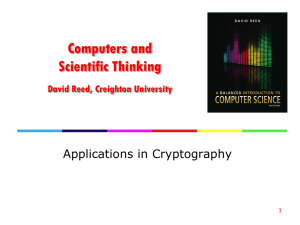In this process of audio encryption from the
advertisement

A Fast Audio Encryption Based Random Sequences Generated Using Linear Feedback Shift Register Defined Over Z4 Yashaswini A S1, Deepak D2 Canara Engineering college, Benjanapadavu 1M.tech Student [4th sem], Dept. of CS&E 1arya.kannanth3@gmail.com 2Asst. Professor Dept. of CS&E 2deepak.d@canaraengineering.in Abstract-Cryptography is an important building block used authentication, and non-repudiation but reveals the fact that in communication system to provide confidentiality and communication is happening. authenticity. Due to the advancement in use of audios in Modern cryptography concerns itself with the following computers, over the internet and other audio communication four objectives: channels the need to secure the audio is very much essential. In the current internet community, secure data transfer is limited due to its attack made on data communication. So i. from being read by non-legitimate persons ) more robust methods are chosen so that they ensure secured data transfer. The Z2 based cryptographic operation is used Confidentiality (a message should be protected ii. Integrity (the receiver should be able to examine in general, presently used in all most all applications has got a whether a message was changed during the major drawback that it can be used by only one kind of transmission) algorithm that is exclusive-OR. In case of extension of algorithm for arithmetic operation, the iii. minimum requirement is Z4. In this work we use this Z4 system of generation of pseudorandom number in audio cryptographic Non-repudiation (the sender should not be able to deny having sent message) iv. Authentication (the receiver should be able to identify the origin of message) application. Cryptography itself can be divided into transposition and Keywords- Non-binary audio cryptography, parallel substitution. processing, Z4 system, additive algorithm, multiplicative algorithm, affine algorithm. Transposition is a rearrangement of letters of a message according to a certain algorithm. In other words 1. Introduction In the field of Data Communication, security-issues have Transposition is an encryption in which the letters of the message are rearranged–(permutation of bits). the top priority. Classical cryptography is one of the ways Substitution is a more robust and versatile form of to secure plain text messages. Cryptography addresses the cryptography. As the name suggests, characters in the necessary elements for secure communication namely original text (known as plaintext in crypto speak), are privacy, confidentiality, key exchange, substituted by other characters or symbols using certain algorithm. Cryptographic systems are divided into two types of II. Binary Audio Cryptography II. systems: I. I. Non-binary Audio Cryptography Secret-Key(Symmetric) cryptosystems 2. Literature Review Public-Key(Asymmetric) cryptosystems 1.1 Secret-Key Cryptosystems: Random binary sequences are used as running key Both the sender and receiver have previously set up secret sequence in stream cipher system. Here message is in the information called key in which they use this information form of binary sequence is encrypted by adding bit by bit for encryption and Decryption. modulo 2 a binary random sequence called key sequence and decrypted at the receiver using the same random key sequence generated at the receiver. Linear Feedback Shift Registers (LFSRs) are important building blocks for generating key-sequences. Maximum length sequences called m-sequences generated by an n stage Figure1.1: Secret key cryptosystems Linear Feedback Shift Registers have very good randomness properties such as long period, ( 2n-1), balance, 1.2 Public-Key (asymmetric) Cryptosystems: The sender uses public key of the receiver to send a message securely. The receiver then uses private key to recover original information. ideal autocorrelation and good statistical properties which are desirable characteristic [1]. Also LFSR can be easily implemented both in hardware and software. However m-sequences have low linear complexity. For an m-sequence of length 2n-1 the linear complexity is n. In this case only 2n consecutive bits are required to determine the feedback polynomial of the LFSR and hence the entire sequence. In the practical stream cipher designs, a large linear complexity of the key stream is obtained by a nonlinear transformation of the LFSR output sequence or nonlinear feedback shift register The use of nonlinear feedback mechanism to produce Figure1.2: Public key cryptosystems 1.3 Audio cryptography: In which the cipher text and the key correspond to music in pseudorandom sequence is discussed in [2], [3]. Some of the methods of transformation define three general design categories combination generators; filter generators and clock controlled generators [2]. which the phase has been changed. Playing the cipher-text and the key together one can obtain music which is either However the existing encryption algorithms use bit by bit loud or quiet depending whether the plaintext is 0 or 1. operations. In this bit by bit the only possible operation is XOR. To introduce other additional operations the Classification of Audio Cryptography: minimum requirement is a byte. This leads to the introduction of Non-binary system i.e our proposed system i. Modulo Additive [4]. ii. Modulo Multiplicative iii. Affine( combination of two) 3. Proposed System Methodology: Transposition and Z4 System [6] for Audio Encryption highlights use of cryptography and their use in highly In this process of audio encryption from the source audio Secured Audio cryptography system. The proposed audio stream is taken. This may be of the format 2 k where k cryptography scheme is perfectly secure and easy to depends on the audio structure. (For example if k is 3 then implement. In this work we discuss the property of binary one byte 4 means 16 bit or two bytes …). After taking the sequences generated using linear feedback shift register [5] data from the source, this will be split in to n number of 2 2 defined over Z4 and its application in audio cryptography. sets. These n sets are encrypted using the method In this algorithm random number is generated based on mentioned in this section earlier. After completion of the feedback shift register with seed value / values. Since the encryption all n number of 22 sets is concatenated to get the audio cryptography has got importance of on-line cipher text. This cipher text is sent to the destination and processing, it should have faster encryption and decryption decrypted accordingly. process. For making the processes faster, we use parallel operation for encryption and decryption. The main objectives of this work are: The proposed system has a block in which we have described about encryption, this block of encryption is divided in to three separate categories. First one is additive second one is multiplicative and last is affine. In additive process encryption and decryption using basic the plain text is added modularly with the key to generate arithmetic operations rather than using ex-OR cipher text. In multiplicative cipher we use the concept of parallel operations in encryption and decryption for multiplication and multiplicative inverse for the encryption faster processing and decryption. In multiplicative inverse only XOR is higher immunity to many types of attacks possible, that means it follows binary system. The last one study and analysis of the properties of the cipher in system with respect to Z4 multiplicative algorithms are used. In which the cipher text In this work we discuss the property of binary which we get from additive is used as plaintext for the sequences generated using linear feedback shift multiplicative. register defined over Z4 and its application in audio cryptography. In this algorithm random number is generated based on feedback shift register with seed value / values. Since the audio cryptography has got importance of on-line processing, it should have faster encryption and decryption process. For making the processes faster, we use parallel operation for encryption and decryption. In this proposed Z4 system we are using 3-algoritms for encryption and decryption process. They are which the combination of both additive and 3.1 Encryption Figure 3.1: Detailed activity diagram for encryption process 3.2 Decryption: Figure3.2 Decryption part of Z4 system for audio encryption model Steps: Steps: 1. N-bit plain text is split into k 2-bits. 2. Each 2-bit plain text is encrypted using the 1. N-bit cipher text is split into k 2-bits. random number generated by the help of mod 4 2. Each 2-bit cipher text is decrypted using the same 3. operation. random number generated used in encryption While encryption additive, multiplicative and process by the help of mod 4 operation. affine operations are used. 4. 3. affine operations are used. The encrypted k bit message is converted from parallel to serial. While decryption additive, multiplicative and 4. The decrypted k bit message is converted from parallel to serial. 3.3 Example: Encryption Part Audio information (Plain text) =123 i.e. 01111011 Additive Cipher (mod 4): 0 1 1 1 1 1 0 1 1 due to the XOR operations. The earlier disadvantage is overcome in this process of Z4. This project adapts the modular arithmetic related algorithms; hence algebraic attack may not be possible. This arithmetic can be implemented if and only if the number of bits used for the operations are greater than or equal to two. This work has got inherent immunity to side channel and known plain text attack, since both encryption and decryption process works in parallel. Cipher text= 202 i.e. 11001010 6. References 4. Result In this work secure audio encryption like, additive, [1] S. Golomb, “Shift Register Sequences”, Aegean Park Multiplicative and affine Non-Binary Systems are used Press (1982) reprint, Laguna Hills,California,1967 with algorithm other than binary, which is more secure than [2] A. Menezes, P, Van Oorschot, and S. Vanstone, binary cipher systems. The processes of affine cipher Handbook of Applied Cryptography. CRC Press,1997 system use two keys, which is for additive and [3] Bruce Schneier, Applied Cryptography, Second multiplicative, which can be considered as double secured. Edition, John Wiley and Sons, 1996. The parallel operation of Z4 systems gives an inherent [4] M.J.B. Robshaw. “Stream Ciphers” , RSA Laboratories nature of side channel attack. The nonlinearity of the key Technical Report TR-701,Version 2.0,July 25, 1995 generation which yields in algebraic attack. Encryption and [5] Andrew Rukhin et.al, “A Statistical Test Suite for decryption process using with more complex algorithm on Random and Pseudorandom Number Generators for the basis of arithmetic operations rather than using ex-OR, Cryptographic Applications ” , NIST Special Publication which is used in the present existing system. Analyzing the 800-22 Revision 1, May2010 properties of cipher system with respect to Z4, by which [6] Raghunandan K R et.al, “ proving that this is faster and more immured way of Efficient transferring audio. It can be used in mobile audio system Applications Using Transposition And MultiplicativeNon- since it is faster in process. This process can also be used Binary System”, JERT Vol. 2 Issue 6, June - 2013 for the encryption of audio storage. Still processing is going on, increase in performance of certain parameter is shown later. 5. Conclusion Basically in almost all existing audio transmission system the security is based on binary encryption and decryption methods. In which algorithm used for the encryption is of only exclusive OR (XOR). Even if the system goes for parallel process, in case of encryption algorithm used is XOR, this leads to less immunity for cryptographic process Audio Encryption Algorithm For Online








